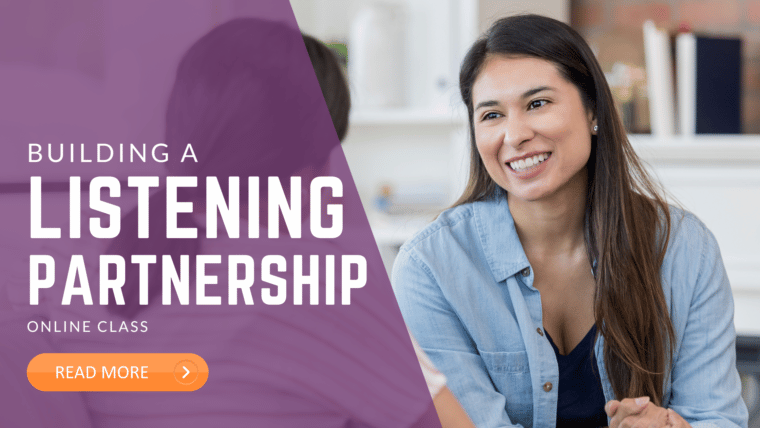
I often hear parents asking this question: “What is Connected Parenting really?”
Is it gentle? Kind? Respectful? Conscious?
The short answer is that it is all of those and still something more.
In this post I’ll share my experiences of using Hand in Hand Parenting’s connected parenting approach – sometimes referred to as parenting by connection.
I’ll include where it got hard, and why, and what made the difference for me, so that I could continue using the approach well in my family with five children, as well as why I love his way of parenting so much.
Looking beyond mainstream parenting tips and advice
Many of us start looking for parenting support when we hit a roadblock. A challenging behavior we can’t seem to solve alone or when usual parenting tactics don’t work.
By the time the behavior starts to disturb or upset other family members, or really seem to be holding a child back, our searches get more determined.
We scroll Google, Instagram, or Facebook groups in the hope that somebody will give us that one piece of advice or parenting hack that will work like dressing on a bad wound.
And, since usual timeouts, consequences, harsh words don’t feel good, and don’t really work, parenting approaches that come from a kinder standpoint feel like the healing balm we need.
This is how it worked for me too.
I searched for positive parenting tips, gentle parenting tips, conscious parenting and respectful parenting advice.
And I liked what I found. Ideas like these:
I was excited and hopeful. They shed some light on my children’s more challenging behavior and gave me some idea of how to work with them.
I saw I could turn around behavior sometimes with just a new turn or phrase or because of a new piece of understanding.
These approaches all hold that a child is good. And that harsh words or punishment is not necessary for bringing up kind, happy children.
It felt like something wasn’t working…
But I soon felt I was lacking something.
Despite all my efforts, my exasperation towards my children was actually increasing.
There were still too many tantrums, according to my standards.
And it felt like they were constantly misbehaving, even while I was trying to do everything to keep them happy and enthusiastic.
Why I got to thinking “Do these parenting tips really work?”
I soon reached a point where I got resentful, thinking, “These tips just do not work!”
I felt like I had some pieces of the jigsaw, but I couldn’t figure out exactly what other pieces I was missing.
And I didn’t want to slip back into timeouts or punishments.
That’s why I started to look deeper.
Starting my connection-based parenting journey
I will never forget my excitement when I finished reading Listen, the book by Patty Wipfler and Tosha Schore, and I said to my husband: “Why has nobody told me before how things work with children?”
The book explained how a breakdown in behavior is to do with a breakdown in connection, and how this feels for children.
And the listening tools I could use to increase connection felt so clear and accessible that I felt an overwhelming urge to give it a go in my family.
I started by getting committed to regular Special Time. Soon it became part of our weekly routine, gradually fitting into our busy schedule.
During these Special Times, I could feel I was just the mum I wanted to be, with my attention 100% devoted to them, their bright ideas, and their very own personalities. We all enjoyed it.
And finally, I could do many more of the things that my kids asked me to do, and that before we hadn’t previously had time for.
My 9-year-old son had received a little wooden plane model to build as a birthday present, and he decided that his Special Times would be devoted to building it with me. Although he had asked me to build it with him a few times already, I had always responded that I could not find time for it. But having committed to offering him Special Time regularly shifted my reply: I finally took the time to sit down with him and just build it, week after week, during his Special Time slot.
I loved these moments together. Finally I had time to be appreciative of the thought, devotion and cleverness he brought to this task.
And it had an overflow effect. I found I had more compassion when he was struggling with his homework, for instance. Also, to my astonishment, he started to hang around me more often when I was preparing dinner or getting ready to go somewhere, and this felt so good.
I felt encouraged, and began using more of the Hand in Hand tools regularly.
What setting loving and playful limits shifted for my children and myself
Learning how to set loving limits was also a game-changer for me. Although setting limits had never been hard for me, I had set them with the intention of controlling my child’s behavior. I hadn’t realised at all what the behavior meant and how limits set like this allowed my children release their emotions so that the behavior would change.
I loved this idea, and my objective shifted from correcting to connecting, either by staying close as they cried, or lightening things up with a playful response. In fact, I’ll never forget the first time I experimented setting playful limits, with my boys:
The winter holiday season had started a few days earlier, and my 7-year-old had begun was bored and disconnected. We had organised a few playdates with schoolmates, but these did not fill his cup.
We had decorated the house with all the usual Christmas ornaments and decorations and his little 4-year-old brother had rediscovered a beloved Santa hat and was wearing it non-stop day and night.
As my 7-year-old complained about the long, ”boring” afternoon ahead of him, he saw his little brother cheerfully reading on the sofa with his Santa hat on.
My 7-year-old grabbed it and started running with the hat on his head, with a nasty grin on his face. His little brother jumped up and started chasing him, screaming and crying.
I decided to chase my 7-year-old too. And as I grabbed his hat with a smile on my face and ran from him, he was surprised.
But he understood that a ”chasing-mummy” game was kicking off and started to chase me happily, his small brother joining in the chase behind him.
After a few giggles, I slowed and laid down on the carpet. My older son was content now, and smiling, and the Santa hat made it back to its owner’s head.
I don’t mind saying that I was pretty satisfied with myself right then, but what made me happier still was how things unfolded later. My 7-year-old picked up the Santa hat from the floor later, put it on his head and ran outside. His small brother noticed 10 minutes later and started shouting.
I actually didn’t not know what to do next but I called him, using a normal tone, no exasperation or threat, and I didn’t mention why. He arrived, looked at me with a quiet face, and noticed his little brother, who already had tears in his eyes.
Without a word, gave him back his Santa hat and ran back outdoors, back to his play. I was amazed. I heard a small “Thank you” coming from his little brother, and I made a mental note to try this tool the next time two kids were fighting for the same toy!
When connection-based tools for children are helpful… but don’t seem to be enough
So, all seemed to be going well. Special Time gave me time to tune into my kids, and give them more of the attention they craved.
As I set limits now, there was time for laughter and crying and I knew I didn’t really have to say or do much except be there.
Because I was now putting connection first, above control, or correction, more regularly, our connection felt stronger.
But it also felt hard.
Soon, I felt empty. I understood all the theories behind what I was doing. How I was making space for my children’s feelings. Supporting their emotional development. That I was connecting with them deeply.
But in practice?
I was exhausted.
Playlistening took time and energy I didn’t have. Setting limits and Staylistening a level of attention and attunement that felt draining.
I knew that change required practice. I was willing to take small steps. But I was out of gas. Even thinking about planning Special Time felt too much effort.
That’s when I returned to the book Listen and read it a second time. Only this time I focused on the one tool I had set aside the first time because it wasn’t directly related to my children.
This was the Listening Partnerships tool.
A tool I resisted to a practice I fully embraced
Of course, I understood the thinking around Listening Partnerships. Still, in my mind, I had the feeling that I already had an appropriate support network around me, between my husband, my sisters, and a few close friends. For that reason, I hadn’t given it more thought.
Plus, I was hesitant.
Listening Partnerships aren’t really a part of other parenting approaches. It felt unfamiliar, and if I’m honest, the practice sounded a bit too intrusive for me.
And yet. Here I was, stuck.
With an offer of a way out.
I trusted the other tools. And I wanted to keep using them. So I finally dived in.
Listening Partnerships are more than a casual debrief you have with your partner at the end of the day, or on a weekly call with friends.
They are opportunities when you can talk with an open heart without fear of getting judged and that really don’t show up often in our usual daily lives.
It took quite a few attempts to speak freely about my emotions and let other mums see my struggles, doubts, and fragilities.
But as soon as I did open up about how hard connected parenting felt things began to change.
This was the biggest revelation I had about parenting by connection
And one day, I had this revelation: giving my children this time and attention was so much easier when someone gave me the same.
This was the missing jigsaw piece I had been searching for.
That’s the thing that makes connection-based parenting so different from so many other approaches.
This tool helps parents tap into their self-compassion, and makes space for them to offload too.
Suddenly things felt complete. I saw now how the tools overlapped.
When I felt heard, I could listen well to my children. I had patience and play came easier.
When things got hard, I could go to my listening partnership and figure out why.
And after I’d let off steam, I could go back and be the compassionate, understanding mum I wanted to be again.
Hand in Hand’s parenting means you are all taken care of. And that was the biggest surprise I had about connected parenting.
It’s funny, because I went into this approach looking for quick tips and hacks to help me handle my children’s behavior.
What could I do to stop them crying? Or fighting? Or struggling with homework.
And what I’ve ended up with is a lot less strategies. Instead I have a framework to use again and again.
It helps me understand why my children’s behavior gets tricky, and then I choose which of the four tools will help me most in that moment.
And I have a way to fill my cup too.
I don’t need to fix anything, or offer suggestions. I can listen. I can empathise. I can connect. And I can receive that too.
It’s not that days don’t get hard. They do.
It’s not like I have kids who never squabble or who cooperate happily all of the time. I don’t.
What I have now by using these connected parenting tools is a way to navigate these times that feel open, connecting and supportive for us all.
That has what has felt so transforming.
If you are new to connected parenting, or have been using a few of the tools for a while, and you feel like things are getting hard, I wonder if you are like me.
Have you tried Listening Partnerships?
They really were the final piece in the puzzle for me and made all the difference.
If you haven’t yet, give Listening Partnerships a try.
Leave guilt, frustration, and short temper behind
We’ll show you exactly how to create a listening partnership so you can become the patient, connected and confident parent you know you can be.
Find out more







